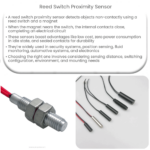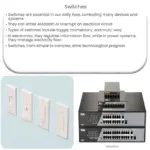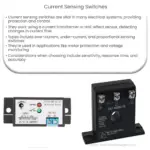Electrical switches work by creating or breaking a circuit, controlling the flow of electricity through connecting or disconnecting conductive materials.
Understanding Electrical Switches
Electrical switches are an integral part of our daily lives, allowing us to control the flow of electricity to various devices and appliances. In this article, we will explore the basic principles behind electrical switches and the various types that exist.
Working Principle
An electrical switch works by creating or breaking an electrical circuit, thereby controlling the flow of electrical current. When the switch is turned on, it connects two conductive materials, forming a closed circuit that allows electricity to flow through. Conversely, when the switch is turned off, it disconnects the conductive materials, breaking the circuit and stopping the flow of electricity.
Types of Electrical Switches
- Single-pole switch: This is the most common type of switch, used for controlling a single light or device. It features two terminals: one connected to the incoming power source, and the other connected to the device being controlled.
- Double-pole switch: Similar to a single-pole switch, but with four terminals instead of two. These switches can control two separate circuits simultaneously, allowing for greater flexibility in electrical systems.
- Three-way switch: These switches have three terminals and are used in pairs to control a single device from two different locations. They can be found in hallways and staircases, where multiple access points are needed.
- Four-way switch: With four terminals, these switches are used in conjunction with two three-way switches to control a single device from three or more locations.
Common Switch Technologies
- Mechanical switches: These switches use physical contact between conductive materials to create or break the circuit. Examples include toggle switches, push-button switches, and rocker switches.
- Solid-state switches: Unlike mechanical switches, solid-state switches do not have any moving parts. They use semiconductor materials, such as silicon, to control the flow of electricity. Transistors and thyristors are common examples of solid-state switches.
- Reed switches: These switches use a pair of magnetic contacts enclosed in a glass tube. When a magnet is brought near the switch, the contacts are drawn together, closing the circuit.
- Optical switches: Optical switches use light to control the flow of electricity. When light shines on a photosensitive material, it changes the material’s resistance, allowing current to flow through. This technology is commonly used in fiber-optic communications.
In conclusion, electrical switches play a crucial role in controlling the flow of electricity in our homes and devices. With a wide variety of switch types and technologies available, understanding their basic principles and functions is essential for effective and safe use.




